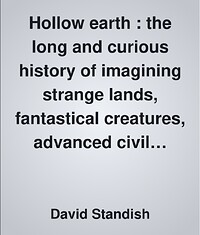Status
Call number
Genres
Collection
Publication
Description
"Beliefs in mysterious underworlds are as old as humanity. But the idea that the earth has a hollow interior was first proposed as a scientific theory in 1691 by Sir Edmond Halley (of comet fame), who also suggested that there might be life down there as well. Hollow Earth traces the many surprising, marvelous, and just plain weird permutations his ideas have taken over the centuries." "Both Edgar Allan Poe and (more famously) Jules Verne picked up the torch in the nineteenth century, the latter with his science fiction epic A Journey to the Center of the Earth. The notion of a hollow earth even inspired a religion at the turn of the twentieth century - Koreshanity, which held that we're all living on the inside." "Utopian novels and adventures abounded at this time, including L. Frank Baum's hollow earth addition to the Oz series and Edgar Rice Burrough's Pellucidar books chronicling a stone-age hollow earth. In the 1940s an enterprising science-fiction magazine editor convinced people that the true origins of flying saucers lay within the hollow earth, relics of an advanced alien civilization. And there are still devout hollow earthers today, some of whom claim there is a New Age utopia lurking beneath the earth's surface, with at least one entrance near Mt. Shasta in California." "Hollow Earth travels through centuries and cultures, exploring how each era's relationship to the idea of a hollow earth mirrored its hopes, fears, and values. Illustrated with everything from seventeenth-century maps to 1950s pulp art to movie posters and more, Hollow Earth is for anyone interested in the history of strange ideas that just won't go away."--Jacket.… (more)
User reviews
The rest of the book mostly consists of summaries of novels that involve an interior world (not always on the hollow shell model). A few deservedly famous works, like Verne's A Journey to the Centre of the Earth, figure, but it's mostly ones that in Standish's own estimation are forgetable to dreadful. I ended up skipping a lot of this, Standish attempts to connect them to then-current fads and fears not being interesting enough to justify the often lengthy summaries.
There's surprisingly little on Hollow Earth in more recent crackpottery, despite repeated references to the flourishing online cottage industry of new-agers and conspiracy theorists who have adopted the idea. Perhaps the idea is that if the reader is interested they can just go out and see for themselves - a selection of links are provided.
Overall, a bit of a disappointment.
Slow at times and too fast at others --in particular, the last
Also, there is a good bibliography and index to assist the reader. A fun little book about a strange idea.
There are more than a few silly mistakes here, and the book is designed fairly poorly, I'm sorry to say. Those things, and the repetitive nature of the text, detract from the idea, which is a fairly interesting one.
Could have been much better than it is.
